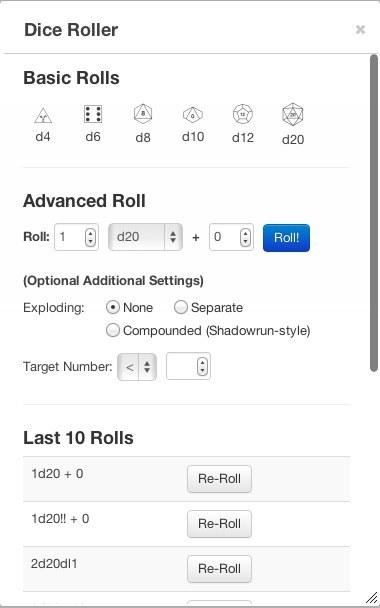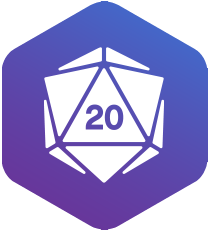
The Roll20 Team
There’s no doubt that a core piece of any virtual tabletop system is the dice roller. After all, almost any game that you play on a tabletop, RPG or otherwise, requires some basic (or even very advanced) dice mechanics. It’s a natural extension of VTT software, then, to try and make that a little easier on the participants through quick dice rolls and support for auto-calculating key mechanics.
Today we’re rolling out a new update to Roll20 that introduces a completely new dice system. And we’re not just talking about the random-number generator (although that’s been upgraded, too!) Let’s break each feature down in turn:
3D Dice
This is the largest change, and it’s one we’re incredibly excited to introduce. The video below does a great job of showing it off:
Enabling 3D Dice is simple: just check the box in the Experimental Features section at the bottom of your My Settings screen (the gear icon, last one on the right sidebar where the text chat is located).
To dive into the specifics, the 3D Dice system shows you a real physics simulation of dice rolling around on your screen. This isn’t anything that’s pre-calculated – we don’t know what the result of the simulation is going to be before it starts, either; which is why you’ll notice the little numbers following the dice around. Those numbers show what the computer is literally “reading” as the top number for each dice as the dice bounce and roll around the screen.
If you enable 3D Dice, then any dice rolls you do will use the 3D system whenever possible (if you roll a standard die, not something crazy like a d7), and up to a maximum of 20 dice at a time; any above that will just be generated randomly the “old fashioned” way. The computer will read the dice as they roll and use that as the result in your dice roll instead of just instantly generating the result with the random number generator.
In addition, any other players that have 3D Dice enabled will see your dice roll happen in real-time on their screen as well! So you can all share in the excitement and suspense of that dice tipping right at the last moment to a natural twenty.
Right now we support d4, d6, d8, d10, d12, and d20 dice in 3D, and we intend to offer skins and possibly additional dice models in the future via the Marketplace.
A very special thanks goes to Kristin Carlson (current member of the Moderator team), who spent a huge amount of time modeling and texturing the dice to get them just right – thanks, Kristin!
New mechanics support
One of the largest threads on our forum has always been the request for further dice mechanics support. We’re always trying to walk the fine line between offering support for broad mechanics without getting into system-specific requests. We’re not trying to automate combat, just make life a little easier.
Eric Dalquist deserves a hearty round of applause for volunteering his time (in addition to his existing Moderator duties) to compile that massive thread into a more concise list of suggestions that span multiple systems. He’s also been working hard to improve the Roll20 Dice System to support those new mechanics, and in today’s update you’ll find support for additional drop-highest and keep-lowest, rerolls, and more! We’ll continue to implement the systems in the new dice thread as quickly as we can.
New easy-to-use dice GUI
Also included in this update is a way to make dice rolling even easier in Roll20. There’s a new icon on the toolbar (looks like a d20, on the left-hand toolbar) that’s available to both players and GMs. It opens up a little dialog box that allows you to make common rolls with just one click, as well as build more advanced rolls in an intuitive manner:
There’s also a listing of your last ten rolls, so you can quickly re-roll any of them with one click. We hope that this new tool makes dice rolling in Roll20 even better, especially for any players who might not be used to text chat slash commands.
Behind-the-scenes changes
We’ve also re-worked the way that the dice system works behind-the-scenes, and you’ll find better error handling, bounds checking (to keep you from doing things like rolling infinite loops), and improved (better distributed) random number generation are all included in this new release.
We’re still working to make even more improvements behind the scenes, so stay tuned, and thanks for all of your support!

